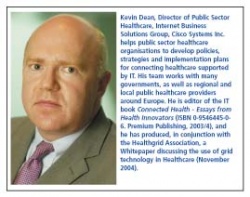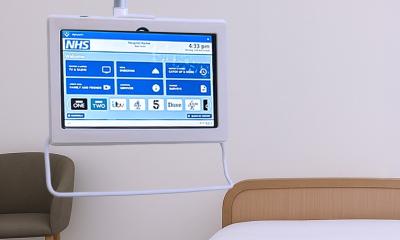Creating Connected Health in Europe
Information is as vital a resource in healthcare today as the scalpel, writes Kevin Dean, adding that patients also expect to have access to the same level of high-quality, timely, customer-centric healthcare services as they have for banking, insurance, travel, and retail interactions. So why, he asks, do healthcare services still lag behind other organisations?
The author also outlines how far some EU countries have progressed today

In the late 1990s, the healthcare industry incubated a series of e-health initiatives but today e-health is still viewed as ‘special’ projects, outside of the normal day-to-day management of care, and there are powerful barriers to extending the use of IT in healthcare. However, healthcare services can no longer ignore the importance of accurate and timely information.
However, to be truly effective, that information must be securely connected across organisations, professional specialisations, and increasingly, national boundaries.
Thus e-health must evolve into ‘Connected Health’, meaning that we must focus on ensuring the secure and timely flow of patient-care information to its point of need. A modern health system must have a portfolio of activities that connect citizens, patients, clinicians and managers:
• Clinical information and tools dealing with complete information set on patient treatment
• Continuous retraining of professionals (and patients) in the most effective treatments and prevention of diseases
• Operational management of healthcare organisations (HR, finance, supply chain)
• Patient/public engagement to help them manage lifestyle, chronic diseases, and communications when under treatment
• Public health and performance monitoring across regional or national health systems.
Such activities must be underpinned by a secure and increasingly interactive infrastructure that allows data to be shared safely and effectively for treatment and prevention. Making this connected environment possible is a Cisco Medical-Grade Network that acts as a digital nervous system, securely and reliably carrying data, voice and video to wherever needed.
Creating Connected Health in Europe - Fortunately, many regional and national governments in Europe have recently recognised the importance of connected information in healthcare. The key change is an increased effort to move from isolated e-health projects to a systematic approach that ensures access, quality, and lower cost of care across wide communities. However, each country’s individual culture, funding, and administrative systems determine very different approaches to creating a Connected Health environment.
Two countries with contrasting approaches are England and Denmark. In 2002 England’s National Health Service (NHS) created a single national programme that provides standardised clinical information tools and record management. Resulting from ambitious goals and schedules, England now has a strong national IT governance structure supported by a multibillion-Euro fund, nationally led procurement and specification of information and technology services, a critical infrastructure that links regional and local organisations securely, and a newly formed organisation that creates national plans and provides resources.
Denmark, on the other hand, has seen comparatively slow, largely user-led and modest increases in functionality over the past 10 years. Led by MedCom, a temporary project organisation chaired by the Danish MoH, the country has sustained standards for clinical messaging. With modest budgets and light staffing, direction is determined by consensus over time. Clinical acceptance has been high, and Denmark is now sharing many lessons learned with other countries (e.g. Baltic E-Health Exchange).
Alternative approaches can be seen in Germany and France. Germany, with its compulsory, highly regulated care system, has few options to encourage dramatic changes in the use of information in healthcare. However, Germany created a national smartcard programme with rapid implementation targets to give each of its 80 million citizens access to a transportable identifier and basic medical record. To increase safety and citizen mobility, the country is also taking a leading role in European interoperability initiatives.
France is looking for ways to control growing healthcare costs by transferring health records between organisations more efficiently. However, its fragmented national, regional, and local management; and its relationship to social security for payment makes for some difficult decisions in terms of budget creation, governance model, and balance between centralised and localised solutions. In the meantime, leading hospitals such as the Centre Hospitalier d’Arras are demonstrating the importance of Connected Health systems. The hospital has transformed its operation from the ground up by re-building the campus, automating administrative processes and enabling a new work culture. A state-of-the-art Cisco medical-Grade Network has provided mobile access to centralised data for hospital staff and regional health centres, helping to improve efficiency, reduce costs and enhance patient care.
Most interesting is the contrast between Western and Eastern Europe. Western European countries, with decades of legacy systems, may well proceed slowly compared to their Eastern neighbours. The new EU members Hungary, Estonia, Slovenia, as well as Bulgaria are developing remarkably sophisticated communication infrastructures, have little legacy and scepticism to overcome, and often have a more general healthcare reform programme to drive information usage. These countries have the opportunity to leapfrog to a Connected Health system in short order and, in the next few years, deliver world-leading health systems where information and knowledge are among the patients’ and clinicians’ most important tools.
For all European countries, the ‘acid test’ for their development of Connected Health is to assess the completeness of their vision and funded plans for IT in healthcare. These include clinical treatment, knowledge and learning, operational management, patient engagement and public health supported by a secure, resilient, and interactive infrastructure. Those with a comprehensive vision for Connected Health will gain immense benefits from information-transforming healthcare.
03.08.2006





